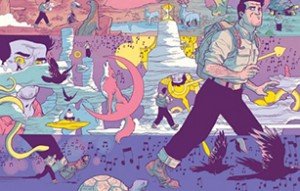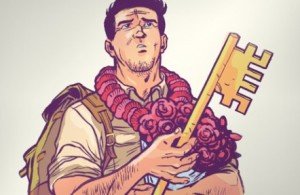Tale of Sand
In the late 60s, Jim Henson and Jerry Juhl collaborated on a screenplay called Tale of Sand, a darkly humorous, extremely ambitious work reminiscent of Time Piece in its imagery-heavy, stream-of-consciousness, deliberately nonsensical (in the Lewis Carroll sense of the word) flow and its surrealist depiction of what is essentially an existential crisis on screen, however much larger in scope to the former film, not only because it was intended to be feature-length but due to the sheer complexity of the visuals.
Like Time Piece, it’s more of a plunge into a bizarre fever dream than a narrative, and it’s probable that its weirdness and therefore probable lack of accessibility accompanied with how expensive it would be to produce led to its never having been made.
Years later, however, the Jim Henson Company archivist/historian Karen Falk rediscovered the screenplay and in 2012, commissioned artist Ramón Pérez to transform it into a graphic novel, which was published by Archaia Entertainment. Since the script itself featured very little dialogue and was mostly composed of descriptions of the visuals that were meant to be on screen, a graphic novel–being essentially a series of storyboards–seemed to be the perfect format to introduce this previously lost piece of Henson history to the public, and having just read it, I completely agree with the decision. I would recommend anyone who is interested in reading it to watch Time Piece first, because it places the rhythm of the work in perfect context.
Someone who hasn’t seen it might be utterly confused by the sometimes very odd juxtapositions of visuals in different frames, but once you come to understand Jim’s wavelength in these films, it becomes very easy to see the film that Jim would have made flickering in your mind’s eye while reading the comic. You can imagine the quick cuts and the presumably jazzy, percussive score that would’ve played underneath them, as well as begin to grok on some level the strange links between each image.
Tale of Sand, which Jim and Jerry referred to as a “surrealistic comedy-drama,” is basically the story of a young man, Mac, traveling alone in the desert, sent on a quest he is neither adequately prepared for nor understands. At the start of the film, he seems to simply appear in a strange town, not entirely sure of how he arrived there or why. Shortly thereafter, the sheriff pulls him aside and tells him that it’s time for him to receive his “instructions”. He hands him a map of the outlying desert, telling him that as long as he follows it, he should be okay. “If you don’t panic,” he adds, “you have a real chance of making it”.
All he has to do is get to Eagle Mountain and he’ll be safe. Whenever Mac tries to ask him what is going on, however, he sidesteps the question, pushing him along. He tells him that, as long as he leaves in 5 minutes, he’ll have a 10-minute “head start”. Oh, and one more thing, “Don’t trust the map” (seconds, of course, after having told him to follow it carefully). Suddenly all of the townspeople emerge and cheer a befuddled Mac on, throwing a huge celebration. The sheriff hands him a bag full of supplies, and then he and the rest of the town warn him, “Run, boy!” And off Mac goes, though still not sure why.
10 minutes later, a mysterious villain, a similarly dark-haired young man with a perpetual sneer, devilishly pointed beard, eye patch (which is why he’s called “Patch”), and impeccable Victorian suit–complete with waistcoat–appears and aims a gun at him. The remainder of the film is basically a protracted chase sequence that reminded me of the famous first line of Stephen King’s The Dark Tower series–“The Man in Black fled across the desert, and the gunslinger followed”–but the other way around, with our Everyman hero being hunted down by this black-suited villain, all the while completely unaware of who the man is and why he has become his target.
And the more he travels, the more bizarre his journey becomes to the point that he’s effectively caught up in an absurdist nightmare full of strange, Carrollian characters and illogic, as well as countless elements from classic Hollywood films. All Mac wants is to find his way back to civilization and to simply light a cigarette, but each time either of these goals seem mildly attainable, particuarly the latter, he’s thrown into an even more outlandish situation, each either absurdly or darkly funny, satirical, eerie, or all at the same time.
These include being attacked by a lion who jumps out of a limo which appears out of nowhere, before being rescued by a big game safari hunter dressed like Dr. Livingstone; happening upon a small, square hut that houses an enormous, bustling 1940s-style nightclub within it, TARDIS-style; having a campfire that he’s about to light his cigarette on be put out by Smokey the Bear; being pushed into a swimming pool full of sharks by a spoiled socialite; finding an old gramaphone with a record within it entitled “Stampede,” which once played calls an actual buffalo stampede around him and then the appearance of a huge military tank; and more.
As it goes on, he is eventually chased by stereotypical Native American “Indians” straight out of an old Western and then suddenly racial stereotypes of Arabs from old Hollywood epics are chasing him as well, finally capturing him and stringing him up, upside down. Until he’s rescued by what seem to be Civil-War-era Union soldiers. And off he runs again. And in a stunningly meta moment, we suddenly see a director–who happens to look exactly like Jim Henson–yell “CUT! That’s a wrap!” For a few seconds, it seems like this might have been a film all along, until one of the harem girls is revealed to be…Patch in drag. Jim hands him some money, and the chase continues anew.
Pages: 1 2



